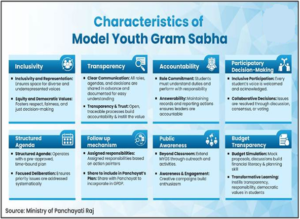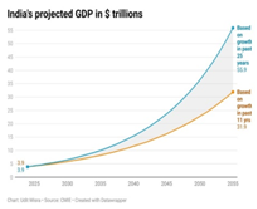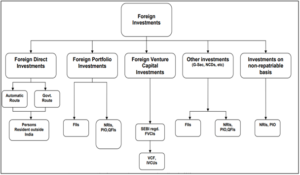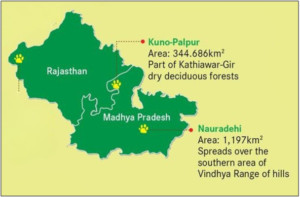श्रेणी: सरकारी योजनाएँ
प्रसंग:
- पंचायती राज मंत्रालय ने शिक्षा मंत्रालय (स्कूल शिक्षा एवं साक्षरता विभाग) और जनजातीय कार्य मंत्रालय के सहयोग से आज नई दिल्ली में आदर्श युवा ग्राम सभा (एमवाईजीएस) पहल का शुभारंभ किया।

आदर्श युवा ग्राम सभा पहल के बारे में:
- प्रकृति: आदर्श युवा ग्राम सभा पहल स्कूली बच्चों के लिए नकली ग्राम सभा सत्रों में भाग लेने हेतु एक अनुकरणीय मंच है।
- ये जनभागीदारी को मजबूत करने और छात्रों को ग्राम सभा सत्रों में शामिल करके भागीदारीपूर्ण स्थानीय शासन को बढ़ावा देने की एक अग्रणी पहल है ।
- मॉडल यूएन पर आधारित: यह देश भर के स्कूलों में मॉडल यूएन – संयुक्त राष्ट्र के एक शैक्षिक अनुकरण – पर आधारित एक पहल है।
- नोडल मंत्रालय: यह शिक्षा मंत्रालय और जनजातीय मामलों के मंत्रालय के सहयोग से पंचायती राज मंत्रालय की एक पहल है।
- कार्यान्वयन: इसे देश भर के 1,000 से अधिक स्कूलों में लागू किया जाएगा, जिनमें जवाहर नवोदय विद्यालय, एकलव्य मॉडल आवासीय विद्यालय (ईएमआरएस) और राज्य सरकार के स्कूल शामिल हैं।
- मुख्य विशेषताएं: कक्षा 9-12 के छात्र सरपंच, वार्ड सदस्य और ग्राम स्तर के अधिकारियों की भूमिका निभाएंगे, जिनमें ग्राम सचिव, आंगनवाड़ी कार्यकर्ता आदि शामिल हैं। वे ग्राम सभा की मॉक मीटिंग आयोजित करेंगे, विभिन्न मुद्दों पर चर्चा करेंगे और गांव का बजट और विकास योजना तैयार करेंगे।
- वित्तीय सहायता: पंचायती राज मंत्रालय मॉक ग्राम सभा आयोजित करने के लिए प्रत्येक स्कूल को 20,000 रुपये की सहायता भी प्रदान करेगा।
स्रोत:
(MAINS Focus)
भारत का 30 ट्रिलियन डॉलर का सपना: आर्थिक अनुमान का आकलन
(जीएस पेपर 3 – अर्थव्यवस्था: वृद्धि और विकास, बाह्य क्षेत्र)
संदर्भ (परिचय)
भारत के वाणिज्य एवं उद्योग मंत्री पीयूष गोयल ने बर्लिन ग्लोबल डायलॉग (2025) में अनुमान लगाया कि भारत अगले 20-25 वर्षों में 30 ट्रिलियन डॉलर की अर्थव्यवस्था बन सकता है ।
- यह वक्तव्य वैश्विक आर्थिक उथल-पुथल के बीच भारत के दीर्घकालिक आर्थिक आत्मविश्वास को रेखांकित करता है।
- वर्तमान में, भारत की नॉमिनल जीडीपी 3.9 ट्रिलियन डॉलर (वित्त वर्ष 2024) है - जो अमेरिकी अर्थव्यवस्था ($29.2 ट्रिलियन) का लगभग आठवाँ हिस्सा है । गोयल का यह कथन बहुध्रुवीय व्यापारिक व्यवस्था में भारत की विकास क्षमता, विनिमय दर की गतिशीलता और आर्थिक लचीलेपन की ओर ध्यान आकर्षित करता है।
आर्थिक आकार और संदर्भ को समझना
- नॉमिनल जीडीपी आधार: भारत का जीडीपी, नॉमिनल शब्दों में मापा जाता है, जो मुद्रास्फीति के समायोजन के बिना घरेलू स्तर पर उत्पादित वस्तुओं और सेवाओं के कुल बाजार मूल्य का प्रतिनिधित्व करता है।
- तुलनात्मक पैमाना: 2024 तक, कैलिफोर्निया की अर्थव्यवस्था ($4.1 ट्रिलियन) भारत की कुल जीडीपी से अधिक है, जो उस अंतर को दर्शाती है जिसे भारत 2050 तक पाटना चाहता है।
- वैश्विक भार: सकल घरेलू उत्पाद का आकार वैश्विक आर्थिक प्रभाव, व्यापार वार्ता लाभ और निवेश आकर्षण को निर्धारित करता है।
- विनिमय दर कारक: 2014 में रुपया-डॉलर की दर ₹65 थी; 2024 तक यह घटकर ₹84 हो गई, जिससे भारत के सकल घरेलू उत्पाद के डॉलर मूल्य पर प्रभाव पड़ा।
- रूपांतरण महत्व: 330 ट्रिलियन रुपए की रुपया-आधारित जीडीपी 5 ट्रिलियन डॉलर की अर्थव्यवस्था में तभी परिवर्तित होगी जब विनिमय दर स्थिर हो जाए - जो विकास और मुद्रा की मजबूती के परस्पर प्रभाव को दर्शाता है।

गोयल के 30 ट्रिलियन डॉलर के अनुमान का आधार
- ऐतिहासिक विकास प्रवृत्ति: 2000-2024 के बीच , भारत की नॉमिनल जीडीपी 11.9% की सीएजीआर से बढ़ी , जबकि रुपये में प्रति वर्ष 2.7% की गिरावट आई ।
- अग्रिम अनुमान (25-वर्षीय क्षितिज): यदि ये रुझान जारी रहते हैं, तो भारत 2048 तक 30 ट्रिलियन डॉलर की अर्थव्यवस्था प्राप्त कर सकता है , जो गोयल के 20-25-वर्षीय क्षितिज के अनुरूप है।
- विनिमय दर प्रभाव: मध्यम मूल्यह्रास निर्यात प्रतिस्पर्धात्मकता में सहायता करता है, लेकिन डॉलर आधारित जीडीपी मूल्यांकन को कम करता है।
- नॉमिनल बनाम वास्तविक जीडीपी: अनुमानों में नॉमिनल वृद्धि दर का उपयोग किया जाता है; वास्तविक जीडीपी (मुद्रास्फीति-समायोजित) वृद्धि काफी कम होगी लेकिन फिर भी उत्पादक विस्तार का संकेत देगी।
- दीर्घकालिक दृष्टिकोण: इस प्रक्षेपण में नीतिगत निरंतरता, जनसांख्यिकीय लाभांश और सतत पूंजी निर्माण को शामिल किया गया है।
हालिया मंदी: एक वास्तविकता की जाँच
- 2014 के बाद का प्रदर्शन: नॉमिनल जीडीपी वृद्धि दर धीमी होकर 10.3% सीएजीआर (2014-2025) हो गई , जबकि रुपये का अवमूल्यन बढ़कर 3.08% वार्षिक हो गया।
- संशोधित परिणाम: वर्तमान वृद्धि-मूल्यह्रास प्रवृत्तियों के तहत, भारत 2055 तक ही 30 ट्रिलियन डॉलर के आंकड़े तक पहुंच पाएगा - जो गोयल की समय-सीमा से लगभग 7-8 वर्ष बाद होगा ।
- संरचनात्मक बाधाएं: धीमी विनिर्माण वृद्धि, निर्यात पर निर्भरता और उत्पादकता संबंधी बाधाएं गंभीर चिंताएं बनी हुई हैं।
- राजकोषीय नरमी: राजकोषीय समेकन प्रयासों और मुद्रास्फीति नियंत्रण ने विस्तार को नरम कर दिया है।
- नीति संवेदनशीलता: विकास दर में मामूली परिवर्तन, यहां तक कि 1-1.5% तक भी, दीर्घकालिक परिणामों को कई ट्रिलियन डॉलर तक बदल सकता है।
दीर्घकालिक निहितार्थ और सबक
- चक्रवृद्धि प्रभाव: 25 वर्षों में, छोटे विकास अंतर (11.9% बनाम 10.3%) से विशाल विचलन उत्पन्न होते हैं
- दशकीय गति: प्रत्येक दशक का प्रदर्शन संचयी सकल घरेलू उत्पाद को महत्वपूर्ण रूप से प्रभावित करता है - जो निरंतर उच्च विकास की आवश्यकता पर बल देता है
- विनिमय दर स्थिरता: विश्वसनीय डॉलर-आधारित सकल घरेलू उत्पाद वृद्धि के लिए मुद्रा स्थिरता बनाए रखना महत्वपूर्ण है
- निवेश चक्र पुनरुद्धार: 8%+ की वास्तविक वृद्धि को बनाए रखने के लिए बुनियादी ढांचे, डिजिटलीकरण और हरित उद्योगों में निवेश की आवश्यकता होगी
- जनसांख्यिकीय लाभांश: भारत की कार्यशील आयु वाली जनसंख्या (68% हिस्सेदारी) का उपयोग उत्पादकता-संचालित विस्तार के लिए एक प्रमुख प्रवर्तक बना हुआ है।
आगे की राह
- संरचनात्मक सुधार: कुल कारक उत्पादकता को बढ़ावा देने के लिए श्रम, भूमि और पूंजी बाजार सुधारों को गहन करना ।
- व्यापार प्रतिस्पर्धात्मकता: निर्यात बाजारों में विविधता लाना, वैश्विक मूल्य श्रृंखलाओं में शामिल होना, तथा दीर्घकालिक हितों के अनुरूप संतुलित एफटीए पर वार्ता करना।
- राजकोषीय एवं मौद्रिक समन्वय: उदार लेकिन मुद्रास्फीति-सचेत मौद्रिक रुख के साथ-साथ विवेकपूर्ण राजकोषीय नीति सुनिश्चित करना।
- तकनीकी छलांग: उच्च मूल्य वाले क्षेत्रों के निर्माण के लिए एआई, डिजिटल गवर्नेंस और नवीकरणीय प्रौद्योगिकियों का लाभ उठाना।
- सतत विकास पथ: पर्यावरणीय और सामाजिक स्थिरता के साथ उच्च जीडीपी विस्तार को संतुलित करना , जैसा कि एसडीजी से जुड़ी आर्थिक रणनीतियों द्वारा रेखांकित किया गया है।
निष्कर्ष
पीयूष गोयल का अनुमान आर्थिक दृष्टि से संभव है, लेकिन यह सशर्त रूप से निर्भर है - इसे केवल लगातार दोहरे अंकों की नॉमिनल वृद्धि, मध्यम रुपये के अवमूल्यन और मजबूत संरचनात्मक सुधारों के माध्यम से ही प्राप्त किया जा सकता है।
- यद्यपि भारत की आर्थिक बुनियाद मजबूत बनी हुई है, तथापि 2048 तक 30 ट्रिलियन डॉलर और 2055 तक 30 ट्रिलियन डॉलर के बीच का अंतर यह दर्शाता है कि कैसे मामूली नीतिगत चूक भी दीर्घकालिक परिणामों को नया रूप दे सकती है।
- 30 ट्रिलियन डॉलर का रास्ता महज एक संख्यात्मक लक्ष्य नहीं है, बल्कि तेजी से बदलती वैश्विक व्यवस्था में भारत की संस्थागत लचीलापन, सुधार विश्वसनीयता और जनसांख्यिकीय कार्यान्वयन की परीक्षा है।
मुख्य परीक्षा प्रश्न
प्रश्न: भारत को सदी के मध्य तक 30 ट्रिलियन डॉलर की अर्थव्यवस्था प्राप्त करने के लिए आवश्यक दोहरे अंक की नॉमिनल वृद्धि को बनाए रखने के लिए आवश्यक संरचनात्मक और नीतिगत सुधारों का परीक्षण कीजिए। (150 शब्द, 10 अंक)
स्रोत: द इंडियन एक्सप्रेस






